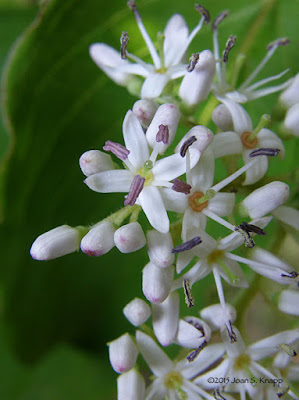I walked around the Fishing Area…
At least one of the Elliott’s Blueberry (Vaccinium
elliottii) plants was ripe.
The Silky Dogwood (Cornus amomum) was in full bloom.
Damselflies were hunting in several places in the Fishing
Area:
a male Blue-fronted Dancer (Argia apicalis); and a…
Blue-tipped Dancer (Argia tibialis).
The Carolina Wild Petunia (Ruellia caroliniensis) now had purple flowers. (Unfortunately, the park staff
has since sprayed that Poison Ivy that was growing around this plant. This plant may be
lost.)
Scrabbling
on a pine tree trunk betrayed a…
female Eastern Fence Lizard (Sceloporus undulatus). Females
may have pale blue badges similar to males.
As I walked towards the Rock Garden, I spotted an unusual
sight…
A pair of Five-lined Skinks (Eumeces [Plestiiodon]
fasciatus) together on a large bolder at the edge of the lake.
On a fallen log at the beginning of the ‘Rock Garden,’ I
found a…
Slime molds are fascinating. Their classification is
complicated but their behaviors are similar. Simply, they have two forms: a
mobile stage in which aggregates of cells, called a plasmodium, move across the
ground and a second spore-bearing stage in which the cells form structures of
different shapes and colors. A time-lapse video of a slime mold may be viewed
here.
From the Rock Garden, I walked on…
the main trail down to the Old Fort, where I found a couple
of pairs of…
Canada Geese (Branta canadensis) socializing on the lake.
On the way back along the main trail to the Fishing area, I
checked on the…
galls on the Shagbark Hickory (Carya ovata) saplings. Whatever had been in
them had burrowed its way out and only the shells of the galls remained.
I found yet another…
Scrambled Egg slime mold on a log near the Fishing Area
parking lot. This plasmodium had divided before the cells entered the
spore-forming stage.
From the trail, I spotted another…
ruellia flower. I thought it was another Carolina Wild
Petunia and almost ignored it since it was located in another Poison Ivy patch.
I did walk over and found, to my delight that it was a…
Stalked Wild Petunia (Ruellia pedunculata), a species I
hadn’t seen before.
I stopped to rest at a table in the Fishing Area before I
continued back along the trail. I startled an…
Eastern Gray Squirrel (Sciurus carolinensis) that
had found a pine cone and wasn’t going to share it with me.
I continued along the trail and, just as I entered the last
wooded section, found a single…
Racemed Milkwort (Polygala polygama) plant in bloom.
Another rewarding walk. It’s interesting that there is
always something interesting to see along this trail. This day was no
exception.
Identification resource:
- Messiah College: Fuligo septica
Related
posts:























No comments:
Post a Comment